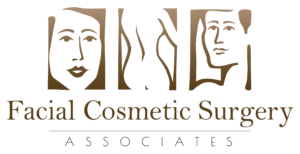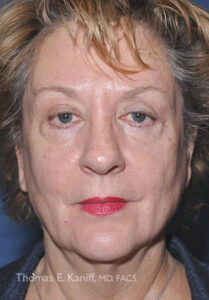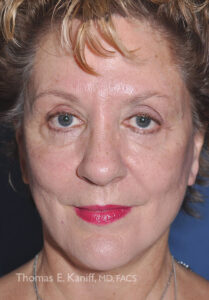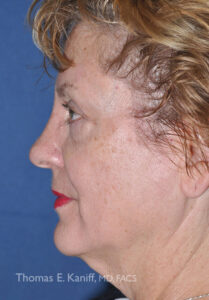As we age, changes in our physical appearance are unavoidable. Wrinkles, drooping skin, and diminished facial volume are typical signs of this process. Although aging is a part of life, it can be disheartening for some to see their looks change in a manner that alters how they appear. However, facelift surgery has emerged as a widely accepted solution for addressing these aging symptoms, helping individuals regain a more youthful look.
At Facial Cosmetic Surgery Associates in Sacramento, CA, we specialize in facelift procedures that rejuvenate and refresh your appearance. Our dedication to facelift surgery is rooted in our desire to provide natural, lasting enhancements that align with your beauty goals. Trust us to redefine your appearance with precision and artistry.
Many patients are candidates for the deep plane facelift, a technique in which a deep plane cheek flap is developed and attachments that hinder repositioning of this flap are released. The cheek flap, including the SMAS layer, is then repositioned in a more elevated, youthful position. Similarly, through an incision behind the ear and along the hairline, a deep plane neck flap is developed to allow repositioning of the superficial neck muscle, creating a sharper, more refined neck line. These deep flaps in the cheek and neck are held in position with deep sutures. These cheek and neck flaps are held in position with deep sutures, excess skin excised and the incisions meticulously closed.
During your facelift consultation, we will listen to your concerns, as well as, examine the face and neck area. A personalized facial cosmetic surgery plan is developed to address your individual concerns, with the goal of a youthful, natural result. Our computer imaging tool is a good communication tool that helps you visualize improvements possible with the facelift procedure. Often other procedures that compliment a facelift procedure are recommended. Other procedures that may be recommended to compliment your facelift include blepharoplasty or eyelid surgery, forehead or brow lift surgery, chin implant, dermal filler, fat transfer, and skin resurfacing.
The facelift procedure repositions the deep tissues and muscles of the underlying cheek and neck are tightened, as well as, removing excess fat and skin giving a natural, rejuvenated appearance to the cheek and neck.
The facelift incisions and techniques used at Facial Cosmetic Surgery Associate vary according to the patient’s needs, but in all cases the incisions are placed along natural skin creases or hidden by hair and are generally imperceptible once they heal.
Facelift cosmetic recovery is generally two to three weeks. Facelift patients return the next day to have a light dressing removed. With the more advanced facelift techniques there is no need for drains, making aftercare easier. Following our comprehensive facelift procedure wound care regimen speeds healing and minimizes bruising. Most patients experience minimal pain after a facelift, but prescription pain medication is available if needed. No bending, lifting or straining is recommended to allow tissues to heal in the correct position. Beginning the third week activities can be gradually increased over time.
What Is a Facelift?
A facelift, medically known as rhytidectomy, is a cosmetic surgical procedure aimed at creating a more youthful appearance by reducing sagging or folds of skin on the cheeks and jawline and other changes in the shape of your face that occur with age. During a facelift, facial skin is lifted off the underlying tissues, excess skin is removed, tissues underneath the skin are tightened, and the skin is repositioned smoothly over the face.
Benefits of Facelifts
Improved Appearance of Aging Signs
Facelifts significantly reduce signs of aging by tightening sagging skin and smoothing out deep wrinkles. This rejuvenation can make individuals look several years younger, enhancing their overall appearance.
Long-Lasting Results
Unlike non-surgical treatments that require regular maintenance, facelifts offer long-lasting results. Patients can enjoy their rejuvenated appearance for many years before potentially needing any touch-ups.
Customizable Procedures
Facelifts can be tailored to meet each patient’s specific needs and goals. Surgeons can adjust the procedure to target specific areas of concern, ensuring results that align with the patient’s aesthetic desires.
Natural-Looking Outcomes
Modern facelift techniques focus on natural-looking enhancements rather than over-tightening the skin. This approach ensures patients look refreshed and rejuvenated, not “pulled” or unnatural.
Correction of Multiple Aging Signs in One Procedure
A facelift can address several aging signs simultaneously, including sagging skin, deep creases, and lost facial volume. This comprehensive approach eliminates the need for multiple different treatments.
Improved Jawline Definition
By tightening the skin and removing excess fat, facelifts can enhance the definition of the jawline. This can lead to a more defined, youthful contour that enhances the overall shape of the face.
Enhanced Neck Contour
Facelifts often include tightening the skin on the neck, significantly improving the appearance of a sagging neck and double chin. This results in a smoother, more defined neck contour, complementing the rejuvenated facial features.
Reduction of Excess Skin
Excess skin that contributes to a tired or aged appearance is removed as part of the facelift procedure. This improves facial aesthetics and can alleviate some discomfort associated with excess skin, such as irritation or difficulty with makeup application.
Combination With Other Procedures
Facelifts can be effectively combined with other cosmetic procedures, such as eyelid surgery or rhinoplasty, for a more comprehensive enhancement. This allows patients to address multiple concerns in a single surgical session, reducing overall recovery time compared to having separate procedures.
What to Anticipate for Facelift Surgery
Consultation
During your initial consultation with us, we will thoroughly assess your medical history and perform a detailed examination of your facial structure. This step is crucial to ensure that a facelift is a safe and appropriate option for you.
We will discuss your aesthetic goals and provide personalized recommendations to achieve your desired outcomes. This is also an excellent opportunity for you to ask questions, address any concerns, and gain a clear understanding of what the facelift procedure entails. We aim to ensure that you feel informed, comfortable, and confident in your decision to proceed with the surgery.
Procedure
The facelift procedure is a meticulous process that typically involves making strategic incisions along the hairline and around the ears. These incisions allow us to access the underlying tissues, lift and reposition the skin, and remove excess. The duration of the surgery can vary, often lasting several hours, depending on the extent of the work required to achieve your desired results.
Recovery
The recovery period following a facelift can differ from patient to patient, but most individuals can expect to resume normal activities within two weeks. It’s common to experience swelling and bruising during the initial phase of recovery; however, these symptoms gradually diminish over time.
Adhering to our post-operative care instructions is crucial for smooth healing and achieving the best possible results. We will provide detailed guidance on how to care for your incisions, manage discomfort, and support your body’s natural healing process to ensure a successful recovery and a beautiful, rejuvenated appearance.
Frequently Asked Questions About Facelifts
Can I Combine a Facelift With Other Cosmetic Procedures?
Yes, combining a facelift with other cosmetic procedures is commonly done to achieve more comprehensive rejuvenation results. Many patients opt to have eyelid surgery, brow lifts, or skin resurfacing treatments in conjunction with their facelift to enhance their overall appearance and achieve a more youthful look. Combining procedures can also be cost-effective and reduce overall recovery time compared to having separate surgeries.
How Long Will the Results of My Facelift Last?
The results of a facelift can last for many years, offering a more youthful appearance long term. Typically, the longevity of facelift results varies among individuals, depending on factors like skin quality, lifestyle, and adherence to post-operative care recommendations. While the natural aging process will continue, patients who maintain a healthy lifestyle and practice good skincare can expect to enjoy their rejuvenated appearance for up to 10 years or more.
Who Is a Good Candidate for a Facelift?
Ideal candidates for a facelift are individuals seeking to address signs of aging, such as sagging skin, deep wrinkles, and lost facial volume. Generally, candidates are in good overall health, have realistic expectations, and possess skin with some elasticity. Factors such as age, health conditions, and lifestyle habits like smoking can affect candidacy. It’s crucial to consult with us to assess your unique needs and determine if a facelift is the right choice for you.
Transform Your Appearance With a Facelift in Sacramento, CA
At Facial Cosmetic Surgery Associates in Sacramento, CA, we pride ourselves on providing exceptional facelift services that cater to your unique aesthetic goals. We are dedicated to delivering results that rejuvenate your appearance and enhance your natural beauty. Opting for a facelift with us means embracing a more youthful and radiant version of yourself.
Ready to explore the transformative power of a facelift? Contact us online or call (916) 480-9080 to schedule a consultation. Let us guide you toward a refreshed, vibrant look reflecting your true self.




